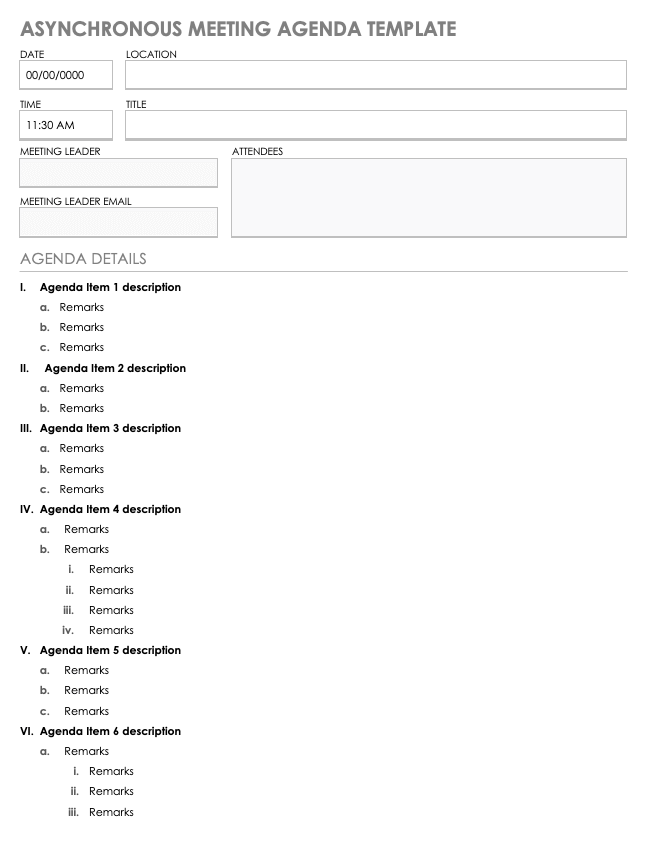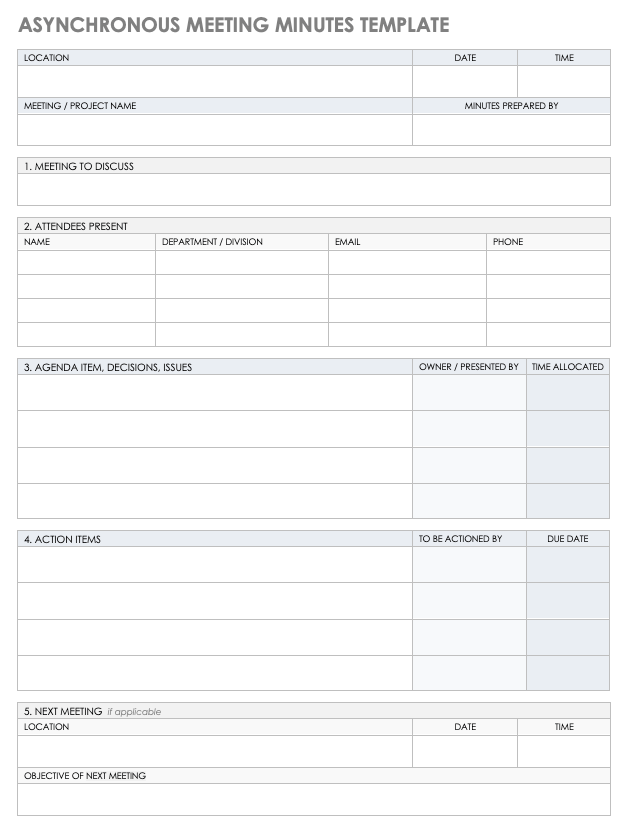What Is Asynchronous Communication?
Asynchronous communication is the intermittent transmission of data that does not require an immediate response.
People can communicate using asynchronous communication without having to be physically present. For example, the following scenario would qualify as an instance of asynchronous communication: You send an email; the recipient of that email views the message, and then responds at a later time.
Asynchronous communication plays a huge role in remote work — in fact, experts call it the future of successful remote work. Because of its flexible nature, this type of communication helps people stay productive, while also maintaining a proper work-life balance. If your work doesn’t require you to be perpetually online, you have more control over your time.
This type of communication is particularly helpful for remote workers and distributed teams, because they can schedule their work responsibilities in accordance with their domestic responsibilities, rather than around rigid office hours. Asynchronous communication grants people the ability to respond when they’re ready and able, after they’ve had sufficient time to think about the message or question at hand.
Examples of Asynchronous Communication
The internet has revolutionized asynchronous communication and enabled its effectiveness. Here are some examples of asynchronous communication:
- Messenger apps
- Status updates (on project, team, or organization levels)
- Weekly announcements (new hire introductions, company-wide announcements, etc.)
- Standups over chat apps (Slack, etc.), especially for distributed software development teams
- Intranets (Yammer, etc.)
Benefits of Asynchronous Communication
There are many benefits to asynchronous communication. It improves productivity, the quality of communication and documentation, and overall team member morale, and also allows for more flexible scheduling.
Advantages of Asynchronous Communication
Here are the many advantages of asynchronous communication:
- Increased Flexibility: People using asynchronous communication methods do not need to respond immediately to any message, email, or chat they receive.
- More Thoughtful Communication: With more time to think about a response and reflect on all potential scenarios, you’re able to communicate more thoroughly, honestly, and insightfully.
- Better Documentation and Transparency: By automatically archiving your communication, asynchronous communication methods allow you to save comments, messages, emails, etc. That way, you can access your documentation at any future point in time, which further eliminates communication redundancy and improves productivity.
- Happier Workers: When people have more control over their workday and the ability to choose their working hours, they are generally happier. Such autonomy empowers employees to structure their time to fit their lifestyle. When managers and coworkers don’t require or expect an immediate response, workers can focus on their own work and respond at their convenience. In addition, happier workers have less stress and, consequently, tend to enjoy better mental and physical health.
- Increased Productivity: Because team members don’t need to focus as heavily on responding to emails or chats, they have more time for complex, more valuable work. Members of your team are also able to get more work done in less time, which allows them to spend larger chunks of time on this more important work. Because they’re focusing on the work that matters — rather than digging themselves out of their email — productivity increases.
- Better Planning: With less stress and fewer distractions, people are able to plan their workdays more thoughtfully and allot more time to the work that matters.
- Fewer Time-Zone Issues: Asynchronous communication levels the playing field for a geographically diverse base of employees. Now, people can send, view, and respond to messages whenever they are available, which makes it easier for companies to retain employees and expand the hiring pool.
- Increased Autonomy and Agency: When someone is able to structure their schedule according to their needs, they feel more empowered and in charge. And, when they have more control over their life, they’re more loyal, they stay at the company longer, and they produce higher quality work.
Challenges of Asynchronous Communication
Although there are numerous advantages to implementing asynchronous communication methods, there are also some challenges. These include longer resolution times, a greater number of misunderstandings, and fewer brainstorming sessions.
How to Build a More Asynchronous Culture
To build a more asynchronous culture among your team members, follow these key steps below:
- Assess the Needs of Your Company: Before you try to implement a variety of new tools and techniques, take the time to analyze the business needs you’re trying to fulfill. Amira Hankin is a Senior Product Designer at Stamen, a strategic design firm with expertise in data visualization and cartography. “Assess the needs of your company in order to better choose the tools that support your larger goals,” she says. As you look into these needs, you should “be intentional about the tools you’re selecting and why.”
- Over-Communicate: When contacting team members, include as much detail as possible in each message, such as screenshots, data points, and slide decks. Be absolutely clear about your requests and any related deadlines.
- Give People Time to Respond: The beauty of asynchronous communication is that people can respond at their own pace, after they’ve given enough thought to their response. Given that flexibility, make sure you build in a few hours (or even days) for people to respond. While you wait, be productive with your time, and do all that you can while waiting for a response.
- Ensure Access to All Necessary Documents: Waiting for viewing or editing permission can add extra, unnecessary response time to a form of communication that’s already slow. For that reason, make sure that everyone has the proper permissions for all documentation ahead of time.
- Share Relevant Information Beforehand: Before you hold a meeting or call, make sure that everyone has all the necessary information available to them, so they are able to actively contribute to the conversation.
- Document All Topics of Discussion: Make sure that you note all topics of discussion and action items during your meeting, so everyone can easily find the information later and refresh their memory. Even better, record the meeting (if possible) so people can review it at their leisure.
- Turn Off Notifications: During high-focus work time and after working hours, make sure you turn off your notifications from email, chat apps, and other forms of communication. Block out specific times of the day to respond to all notifications, so you can maximize your productivity.
- Promote This New Type of Communication Constantly: As previously mentioned, implementing a totally new form of communication can be challenging. Lead by example and promote asynchronous communication among your team members to ensure that everyone aligns themselves with this new process.
How Leaders Can Foster Asynchronous Communication on Their Team
Leaders are the driving force behind changes in an organization, especially when those changes involve the way team members communicate with one another. To create a fully functioning asynchronous organization, take into consideration the points below:
- Eliminate required work hours, specifically those in the office.
- Emphasize trust and accountability within your organization.
- Set team-wide expectations regarding the response times for things like email, chat apps, and more.
- Implement a DRI (directly responsible individual) model of management.
- Emphasize transparency and use communication tools that support it.
- Have specific ways to communicate if an urgent need arises.
- Give team members flexibility, and let them know it is okay not to be available all the time. Be sure to model this behavior for them.
- Promote strong, effective communication, which is the backbone of asynchronous communication.
- Evaluate employees based on their output, not on the number of hours they spend at their desk.
Asynchronous Communication Best Practices
To fully adopt and utilize asynchronous communication, follow these best practices outlined below:
- Realize That Most Things Aren’t Urgent: One of the most important aspects of implementing asynchronous communication is realizing that almost everything can wait for an answer. Whether someone responds within five minutes or five hours, they will most likely not hinder your productivity. If something is truly urgent, decline meetings, propose asynchronous communication methods, and direct message only those staff members to whom the urgency pertains.
- Have Clear Processes: Help people distinguish between when they should send asynchronous emails or chats and when they should schedule a meeting. Doing so will reduce the amount of stress people feel about responding to messages and using the right type of communication. Similarly, use clear processes about when and how to document relevant information, so you don’t miss any details.
- Split Up Time Effectively: While you wait for a response from a team member, work on another project, so you don’t end up with idle time. That way, you can also work around any projects that may be blocking you, and make iterative improvements on other projects while you wait.
- Fully Understand the Nonlinear Workday: More so now than ever, people work at different hours of the day, especially when they live in different time zones. Take this factor into account as you implement asynchronous communication, and consider shifting your schedule to better suit your own hours of productivity. Try out different work schedules and be aware that an asynchronous organization will fully support these varied timetables.
- Utilize Helpful Tools: Another key component of effective asynchronous communication is having a tool that allows you to document and store all information in one place, where everyone can access what they need and get updates in real time. Find a tool that creates this single source of truth, so everyone can remain in the loop.
- Gain Full Support from All Team Members: When you’re integrating new tools into your processes, it “can be hard to implement [those tools] if there isn’t buy-in from everyone on the team,” says Hankin. To mitigate this issue, make sure that you have ongoing conversations about the changes in tools or communication, “whether those be individual conversations or discussions with your boss’s boss regarding how and why you will use these tools,” notes Hankin.
- Aim for Progress, not Perfection: It will take some time to get used to asynchronous communication. Give people time and celebrate the small wins that come from this new form of communication, such as more productive hours in the day and a more flexible work schedule for employees.
Best Practices for Asynchronous Communication on Your Team and in Your Workplace
To maximize the benefits of asynchronous communication across your team — and even across your organization at large — apply some best practices to your approach. Here are some helpful tips to keep in mind:
- Make all important information available and provide it up front.
- Ensure that your writing is clear, precise, and thoughtful.
- To maximize productivity, block your day, so team members know when you’re available and when you’re offline.
- Batch your email and correspondence time into a couple of sessions per day, and set up an autoresponder for the times during which you plan to be inactive on email.
- Share your communication hours and preferences with team members, so they’re aware of when you’ll be most responsive.
- Send all notifications, chats, and emails with context in order to give team members enough information to act on a message.
- Avoid needless @ mentions and direct chats.
- Work to reduce your reliance on synchronous communication tools. Try removing these tools from your phone, so you don’t feel pressure to respond to messages at all times.
To learn how asynchronous tools can help your team be more productive, visit our ultimate guide to asynchronous communication and collaboration tools.
Best Practices for Asynchronous Meetings
As you adopt these asynchronous forms of communication and start to put them into practice, you’ll also start holding asynchronous meetings. To create the most effective meetings using this new type of communication, apply the following best practices:
- Share an agenda beforehand, so meeting attendees are aware of discussion topics and can add notes.
- Use a central portal and share it with team members, so everyone can easily upload and collaborate on notes, schedules, progress updates, and reference documents.
- Implement a project management system that enables you to build workflows, so team members can track their daily tasks across multiple projects.
- Utilize an asynchronous video tool that allows you to share messages with as many people as necessary. Doing so will enable everyone to review a video or revisit a slide deck at their convenience.
- Be honest about whether or not a meeting can occur in writing. If you deem a meeting necessary, make sure there’s a concrete meeting agenda with action items.
- Hold a post-mortem meeting to determine whether a synchronous meeting was successful or whether you could have handled it asynchronously.
- Encourage everyone to speak up during asynchronous meetings.
- Set guidelines for the type of feedback and input that should occur during a meeting, and keep the meeting in check and on track as it progresses.
Asynchronous Communication Templates
Asynchronous Meeting Agenda Template
Download Asynchronous Meeting Agenda Template
Use this helpful template to set up an agenda for an asynchronous meeting. List all the essentials for your meeting, including attendees, overall objectives, a minute-by-minute meeting schedule, and the meeting lead’s contact information.
This template ensures that your asynchronous meeting will be an effective use of everyone’s time.
Asynchronous Meeting Minutes Template
Download Asynchronous Meeting Minutes Template
Use this helpful meeting minutes template to stay organized and keep everyone on the same page during your asynchronous meeting.
Designed specifically with asynchronous communication in mind, this template allows you to list meeting attendees and the meeting agenda, track decisions and issues, and brainstorm with action items, so everyone can stay current concerning the plan as it moves forward.
What Is Synchronous Communication?
Synchronous communication, which is the antithesis of asynchronous communication, refers to real-time and all-the-time communication that you generally conduct on a face-to-face basis.
When practicing synchronous communication, people respond immediately and learn new information on the fly. Examples of synchronous communication include on-site meetings, real-time chats, phone calls, and more.
The Difference between Asynchronous and Synchronous Team Communication
Synchronous communication happens in real time and requires immediate responses, whereas asynchronous communication does not occur instantaneously and allows for varied response times.
Many organizations have adopted asynchronous communication because its increased flexibility gives people more control over their schedules, which allows them to determine when they respond to emails, chats, or other notifications. The method also offers each team member more autonomy, which reduces the stress associated with always having to be online and minimizes the need to coordinate the schedules of a geographically diverse staff.
Synchronous communication, on the other hand, emphasizes deadlines and hard-and-fast response times, which can add stress and potentially lead to burnout. This method also creates the constant threat of interruptions by email, chats, or other forms of communication. Synchronous communication, by definition, divides one’s attention, which increasingly makes it difficult to engage in deep, focused work.
Moreover, the expectation of immediate responses in synchronous communication lowers the quality of those responses, and ends up necessitating more discussions and less time to come up with optimal solutions. Synchronous communication tends to prioritize connectedness over productivity, which creates an environment that does not always yield the best solutions for your organization.
Striking a Balance Between Asynchronous and Synchronous Communication
Although asynchronous communication is becoming much more popular, there are instances in which synchronous communication makes more sense.
Synchronous communication is better for the following:
- Shallow, less serious work (e.g., responding to emails or chats, arranging logistics, or scheduling status meetings)
- Team building, casual hangouts, or socializing across teams and organizations
- Situations that are urgent and require an immediate response (e.g., when a server is down)
- Collaboration or brainstorming sessions
- Team retreats, celebrations, or coworking situations
- Troubleshooting
- First-time meetings with external parties or vendors
- Any topics that are emotionally sensitive and require a face-to-face discussion
Asynchronous communication is better for the following:
- Complex, intense work that requires more time and energy (e.g., researching a solution to a problem, writing a launch plan or campaign brief, or creating a presentation deck)
- Company discussions and updates
- General feedback
- New team member introductions
- Detailed technical conversations
- Project discussions
Asynchronous vs. Synchronous Quiz or Checklist
To help you determine whether you should use asynchronous or synchronous communication in a particular situation, consult this helpful checklist.
Do you need to document it for later reference? (Y/N)
Does it require an immediate response? (Y/N)
Do you consider it urgent? (Y/N)
Does it require thoughtful feedback from others? (Y/N)
Does it require substantial time and dedication? (Y/N)
Does the situation require a face-to-face meeting? (Y/N)
Does it include emotionally sensitive material or topics? (Y/N)
Implement Effective Asynchronous Communication with Smartsheet
Empower your people to go above and beyond with a flexible platform designed to match the needs of your team — and adapt as those needs change.
The Smartsheet platform makes it easy to plan, capture, manage, and report on work from anywhere, helping your team be more effective and get more done. Report on key metrics and get real-time visibility into work as it happens with roll-up reports, dashboards, and automated workflows built to keep your team connected and informed.
When teams have clarity into the work getting done, there’s no telling how much more they can accomplish in the same amount of time. Try Smartsheet for free, today.


